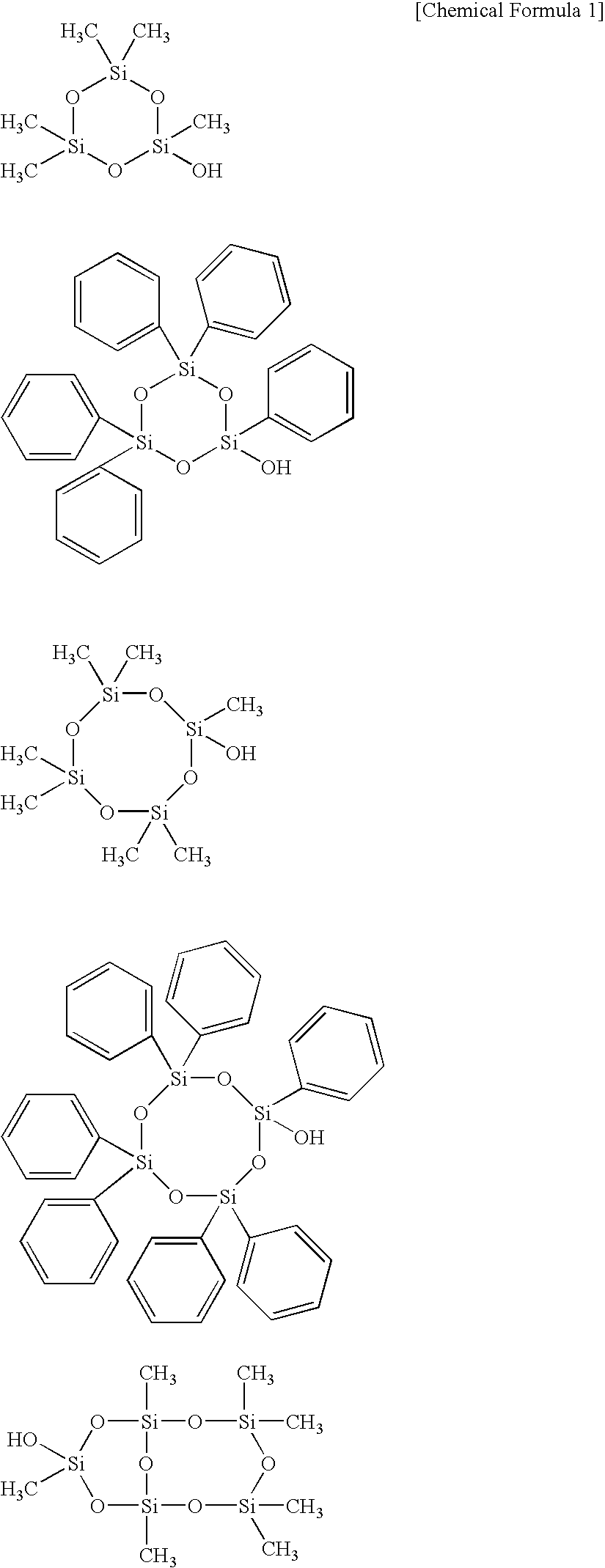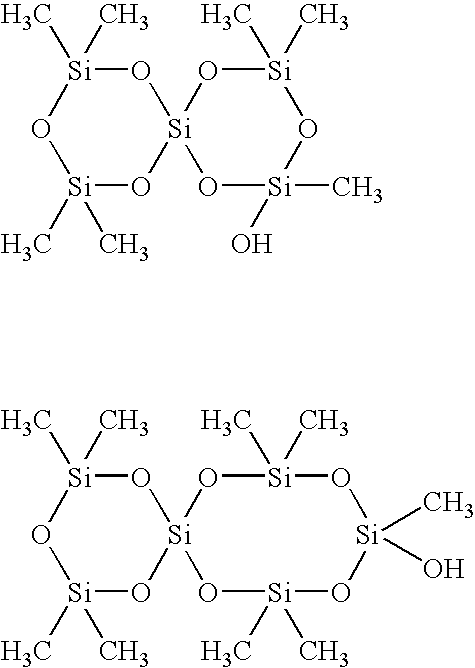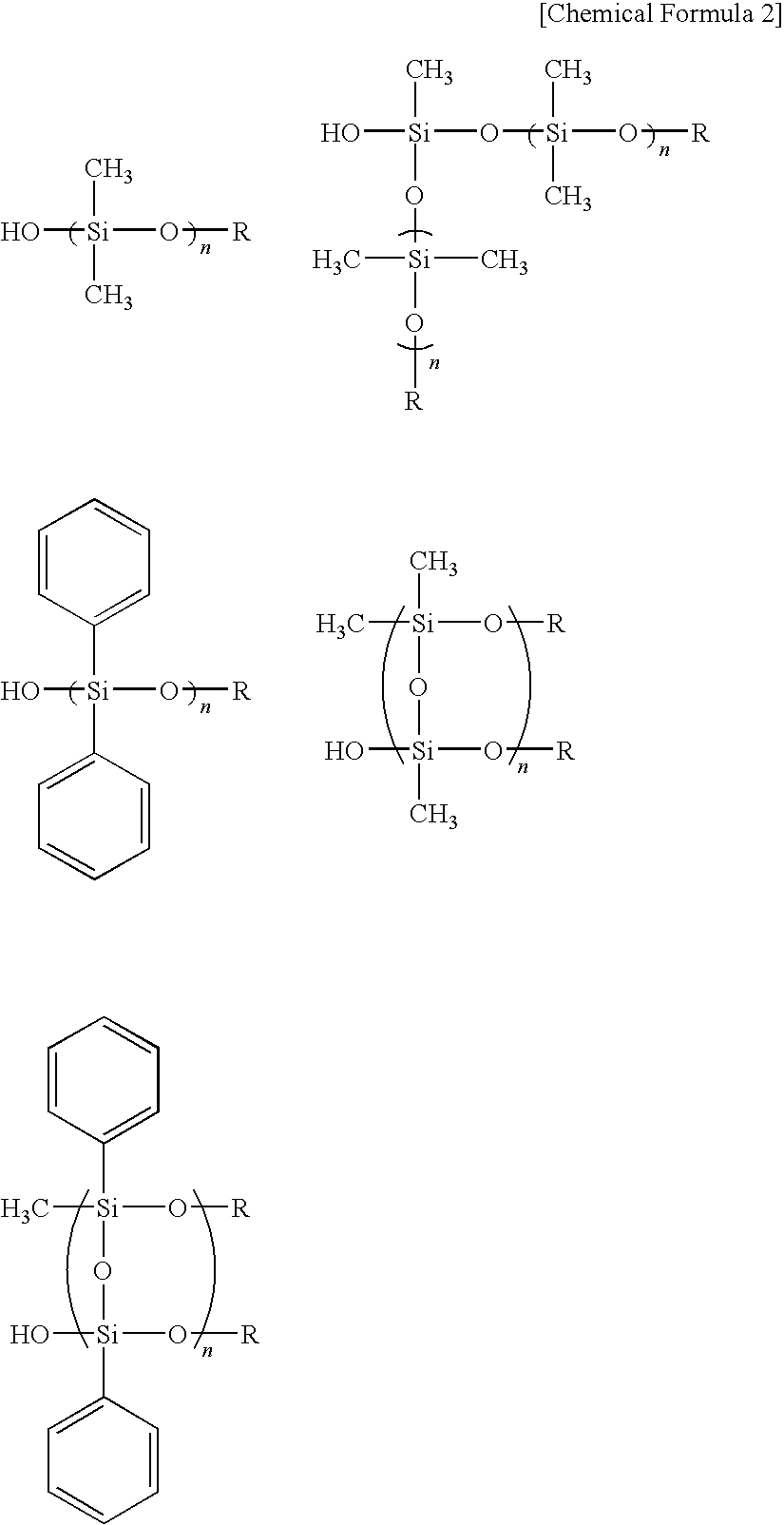Curable composition
a composition and composition technology, applied in the field of curable compositions, can solve the problems of insufficient effect of reducing short-term surface tack, insufficient weatherability of silicon-based sealing materials, stained surface of sealing materials, etc., and achieve the effect of less stained surface, no cracking or discoloration on the surface, and no cracking or discoloration
- Summary
- Abstract
- Description
- Claims
- Application Information
AI Technical Summary
Benefits of technology
Problems solved by technology
Method used
Image
Examples
synthesis example 1
Synthesis of Poly(n-butyl Acrylate) Having Halogen at End
[0226]In a 50 ml flask, 0.63 g (4.4 mmol) of cuprous bromide, 0.76 g (4.4 mmol) of pentamethyldiethylenetriamine, 5 ml of acetonitrile, 1.6 g (4.4 mmol) of diethyl 2,5-dibromoadipate and 44.7 g (349 mmol) of n-butyl acrylate were charged and, after freeze deaeration was carried out, the mixture was reacted under a nitrogen atmosphere at 70° C. for 7 hours. The reaction product was refined by removing a copper catalyst through a column made of active alumina to obtain a polymer having a Br group at a terminus. The resultant polymer had a number average molecular weight of 10,700 and a molecular weight distribution of 1.15.
Synthesis of Poly(n-butyl Acrylate) Having Alkenyl Group at Terminus
[0227]Under a nitrogen atmosphere, 35 g of the poly(n-butyl acrylate) having a Br group at a terminus obtained above, 2.2 g (16.1 mmol) of potassium pentenoate and 35 mL of DMAc were charged in a 200 ml flask and the mixture was reacted at 70°...
synthesis example 2
Synthesis of Hydroxyl Group-Terminated Polypropylene Oxide
[0229]In an autoclave, 0.04 g of a zinc hexacyanocobaltate-glyme complex, a THF solution of 2.0 g of dipropylene glycol and 9.6 g of propylene oxide were charged and the mixture was reacted under a nitrogen atmosphere at 76° C. Then, 145.2 g of propylene oxide was added to the reaction system. The resultant reaction product was refined by recovering the unreacted monomer and the solvent to obtain 150 g of an oily product. As a result of GPC analysis, the resultant product showed a single peak and had a molecular weight distribution (Mw / Mn) of 1.14. The hydroxyl value was 11.8 mgKOH / g.
Synthesis of Unsaturated Group-Terminated Polypropylene Oxide
[0230]To the 120 g of the hydroxyl group-terminated polypropylene oxide obtained above, 5.8 g (30.2 mmol) of a methanol solution (28% by weight) of sodium methoxide was added and the mixture was reacted in an autoclave at 130° C. for one hour, followed by vaporization under reduced pres...
example 1
[0233]100 parts by weight of the polymer obtained in Synthesis Example 1 was mixed with 1 part by weight of a photopolymerization initiator (manufactured by Ciba Specialty Chemicals Inc. under the trade name of IRGACURE 651), 50 parts by weight of diisodecyl phthalate (manufactured by New Japan Chemical Co., Ltd. under the trade name of SANSOCIZER DIDP) and 20 parts by weight of an epoxy-based plasticizer (manufactured by New Japan Chemical Co., Ltd. under the trade name of SANSOCIZER E-PS) as plasticizers), 120 parts by weight of surface-treated colloidal calcium carbonate (manufactured by Shiraishi Kogyo Co., Ltd. under the trade name of HAKUENKA CCR), 20 parts by weight of ground calcium carbonate (manufactured by Shiraishi Calcium Co., Ltd under the trade name of Whitone SB), 2 parts by weight of a thixotropic agent (manufactured by Kusumoto Chemicals, Ltd. under the trade name of DISPARON305), 1 part by weight of a benzotriazole-based ultraviolet absorber (manufactured by Ciba ...
PUM
| Property | Measurement | Unit |
|---|---|---|
| gel permeation chromatography | aaaaa | aaaaa |
| weight average molecular weight | aaaaa | aaaaa |
| Mw | aaaaa | aaaaa |
Abstract
Description
Claims
Application Information
 Login to View More
Login to View More - R&D
- Intellectual Property
- Life Sciences
- Materials
- Tech Scout
- Unparalleled Data Quality
- Higher Quality Content
- 60% Fewer Hallucinations
Browse by: Latest US Patents, China's latest patents, Technical Efficacy Thesaurus, Application Domain, Technology Topic, Popular Technical Reports.
© 2025 PatSnap. All rights reserved.Legal|Privacy policy|Modern Slavery Act Transparency Statement|Sitemap|About US| Contact US: help@patsnap.com



